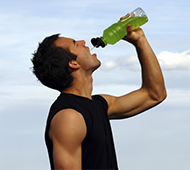Key Tips on Hydration for sport performance
Severe dehydration impairs performance and increases the risk of heat illness, but drinking too much can also be harmful or uncomfortable.  Every athlete is different because they have different sweat losses and different opportunities to drink fluid during their workouts and events.
Every athlete is different because they have different sweat losses and different opportunities to drink fluid during their workouts and events.
Every athlete needs a personal hydration plan and they have to play a role in developing this.
The following are three simple steps that may help to guide hydration practices:
- Sport sessions should be started well hydrated. The aim is to develop fluid practices over the day that keep pace with regular fluid needs as well as the additional losses from exercise or hot environments. As losses change, so should drinking practices. Fluid intake should be spread over the day.
- A targeted drinking plan for training and competition should be developed. This should be based on several pieces of information including individual sweat losses, the opportunities to drink, and feedback from individual feelings of comfort and thirst. Sweat losses and the success of the drinking plan during training sessions in different situations should be monitored (see overleaf).
- Watch out for “salty sweaters”, they may need drinks with more salt and may need more salt in food when sweat losses are high. To check whether someone is a salty sweater, ask him/her to wear a black T-shirt in training and look for salt stains (white powder) under the arms and on the chest.
High salt losses may be a contributing factor in some cases of muscle cramp. Sports drinks with higher salt (sodium) levels (e.g. 300-500 mg sodium per 500 mL liquid) may help reduce the risk of cramps for some athletes.
Read more about this topic and find a downloadable pdf of Key Tips on Hydration for Sports performance